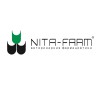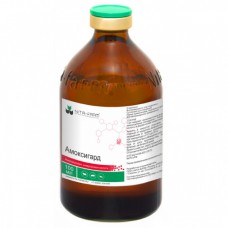Expiration date: 01/2026
DESCRIPTION
Amoxygard (Amoxygard) suspension for injection for the treatment of animals with bacterial infections of the respiratory tract, gastrointestinal tract, genitourinary system, soft tissues and skin. In appearance, the drug is an oily suspension of light cream color.
STRUCTURE
In 1 ml of the drug as an active substance contains 140 mg of amoxicillin (in the form of amoxicillin trihydrate) and 35 mg of clavulanic acid (in the form of potassium clavulanate), as well as excipients: butylhydroxytoluene-2 mg and propylene glycol dicaprilate / dicaprate-up to 1 ml.
PHARMACOLOGICAL PROPERTIES
Amoxigard is a combined antibacterial drug. The drug has a wide spectrum of bactericidal activity against most Gram-positive and gram-negative microorganisms, including beta-lactamase-producing strains: Staphylococci, Streptococci, Corynebacteria, Clostridia, Bacillus antracis, Actinomyces bovis, Peptostreptococcus spp., Escherichia coli, Salmonellae, Bordetella bronchiseptica, Campilobacter spp., Klebsiellae, Proteus spp., Pasteurellae, Fusobacterium necrophomm, Bacteroides, Haemophilus spp., Moraxella spp., Actinobacillus pleuropneumoniae and Aclinobacillus ligneresi.
Resistance to beta-lactam antibacterial drugs is usually due to the ability of microorganisms to produce beta-lactamase, an enzyme that destroys the beta - lactam ring of an antibiotic before it can have an effect on the bacterium.
Clavulanic acid, which is part of Amoxigard, inactivates beta-lactamase and thereby restores the sensitivity of bacteria to the bactericidal action of amoxicillin in concentrations that are easily reached in animal tissues after administration of the drug.
According to the degree of exposure to the body, Amoxigard belongs to low-hazard substances (hazard class 4 according to GOST 12.1.007-76). In the recommended doses, it is well tolerated by animals, does not have a local irritant and sensitizing effect.
DOSAGE AND APPLICATION
Amoxigard is prescribed for: cattle - for the treatment of respiratory diseases of bacterial etiology, obstetric and gynecological diseases-metritis and mastitis, surgical diseases, including soft tissue infections (such as abscesses, phlegmons, etc.); pigs - for the treatment of bacterial infections of the respiratory system, colibacteriosis, postpartum infections in sows (metritis, mastitis, agalactia); for dogs and cats-for the treatment of respiratory diseases, urological infections, skin and soft tissue diseases (abscesses, pyoderma, inflammation of the paraanal glands, gingivitis, etc.).
Dogs and cats are given the drug intramuscularly or subcutaneously, cattle and pigs-only intramuscularly. The injection site after administration of the drug is recommended to massage. Amoxigard is administered to animals at a dose of 1 ml of the drug per 20 kg of animal weight. The drug is administered once a day, the course of treatment is usually from 3 to 5 days. Before each use, the bottle with Amoxigard is thoroughly shaken until a homogeneous suspension is obtained. For the administration of the drug, only dry syringes and needles are used.
SPECIAL INSTRUCTIONS
Symptoms of drug overdose have not been established. The features of the action at the first application and at the cancellation of the drug were not revealed.
Skipping the next dose of the drug should be avoided, as this can lead to a decrease in therapeutic effectiveness. In case of missing one dose, the use of the drug is resumed in the same dosage and according to the same scheme. Do not administer a double dose to compensate for the missed dose.
Do not mix Amoxigard in the same syringe with other medications.
Milk can be used for food purposes no earlier than 80 hours after the last application of the drug.
Milk obtained before the expiration of the specified period can be used for feeding animals after heat treatment.
Slaughter of animals for meat is allowed no earlier than after 14 days.
The meat of animals forcibly killed before the expiration of the specified period can be used for feeding fur-bearing animals or for the production of meat and bone meal.
Meat at the site of administration of the drug can be used for food purposes after 31 days.
If the slaughter is performed earlier than 31 days after the last injection of the drug, the injection site is cleaned and culled.
CONTRAINDICATIONS
Contraindications to the use of Amoxigard are individual hypersensitivity of animals to beta-lactam antibiotics. With the development of allergic reactions, the drug is canceled and antihistamines are prescribed.
SIDE EFFECTS
When using Amoxigard according to the instructions for use, side effects and complications were not established.
SHELF LIFE AND STORAGE
The drug is stored in the manufacturer's closed packaging, separately from food and feed, in a dry place protected from direct sunlight at a temperature of 5°C to 25°C. The shelf life of the drug, subject to storage conditions , is 2 years from the date of production, after opening the bottle-no more than 28 days.
Amoxiguard
(Amoxicillin)
100ml
- Brand: Nita-Farm


